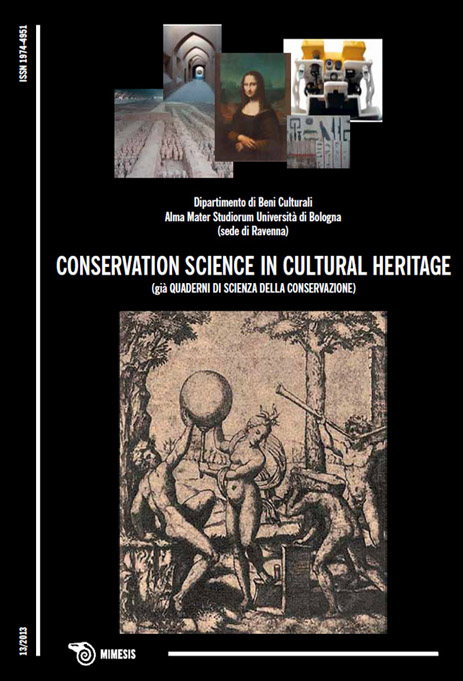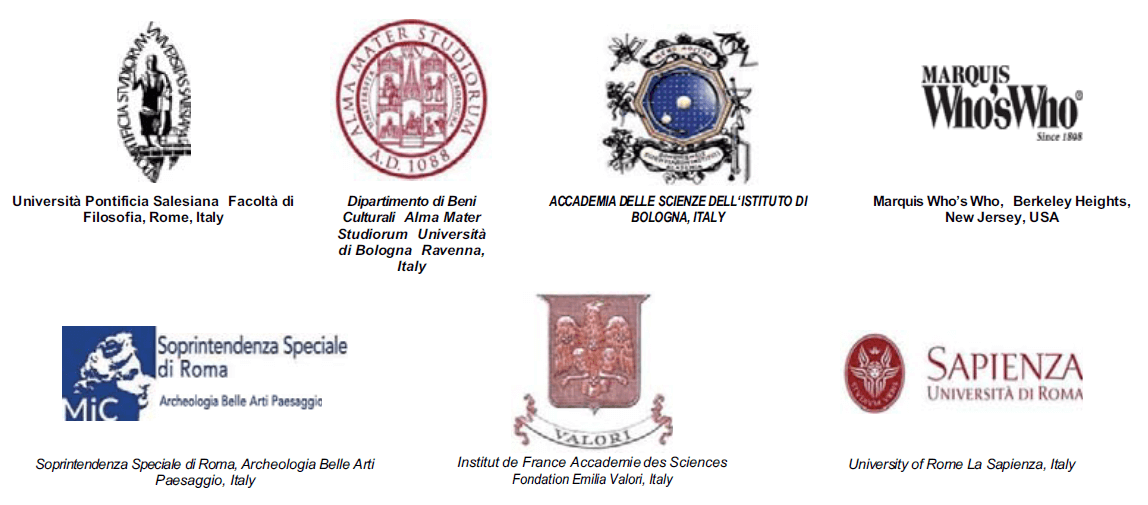The research project BLU-ARCHEOSYS: innovative technologies and advanced systems in support of underwater archaeology
DOI:
https://doi.org/10.6092/issn.1973-9494/4193Keywords:
technology, underwater, education, analyticAbstract
Summary
In this article we summarize the main findings of the research project, BLU- ARCHEOSYS. It ranges from results achieved in the support systems of the human operations carried out directly in the underwater world, such as vision systems for 3D reconstruction of the seabed, multicomponent and innovative configuration ROV platforms. Ample space is given to software systems for data virtualization, and numerical simulation applied to the design of interventions for the recovery of shipwrecks. Important results have been achieved in the analysis of underwater findings, where interesting results have been obtained in the use of particle accelerators and morphological characterization of new varieties. Lastly, mention is made of the survey methodology designed specifically to orchestrate the great variety and quantity of knowledge made available by the project partners.
Riassunto
In questo articolo di natura divulgativa vengono sintetizzati i principali risultati del progetto di ricerca BLU-ARCHEOSYS. Si spazierà da risultati conseguiti nell’ambito dei sistemi a supporto dell’ operatività umana svolta direttamente nel mondo sommerso, come sistemi di visione per la ricostruzione 3D di fondali marini, a piattaforme ROV multicomponenti ed innovativi nella loro configurazione. Ampio spazio sarà dato ai sistemi software per la virtualizzazione dei dati, e la simulazione numerica applicata alla progettazione di interventi di recupero dei relitti. Nell’ambito dell’analisi dei ritrovamenti subacquei sono stati raggiunti importanti risultati, grazie all’utilizzo di acceleratori di particelle e nella caratterizzazione morfologica dei ritrovati. Ultimo, ma importante cenno, sarà dato alla metodologia di indagine pensata ad hoc per orchestrare una tale varietà e quantità di conoscenze messe a disposizione da parte dei partner del progetto.
Résumé
Dans cet article destiné à la vulgarisation sont résumés les principaux résultats du projet de recherche BLU-ARCHEOSYS, à partir des résultats obtenus dans les systèmes d’aide aux interventions humaines dans le monde submergé, tels que les systèmes de vision pour la reconstruction en 3D des fonds marins, jusqu’aux plates-formes ROV multicomposants, caractérisées par leur configuration innovante. Une large place sera accordée aux systèmes logiciels pour la virtualisation des données et pour la simulation numérique appliquée aux interventions de récupération des épaves. Des résultats importants ont été atteints dans l’analyse des découvertes sous-marines et dans la caractérisation morphologique de celles-ci, grâce à l’utilisation d’accélérateurs de particules. En dernier point, mais non le moindre, il sera fait mention de la méthodologie d’étude qui a été conçue ad hoc pour agencer une telle variété et quantité de connaissances, qui ont été rendues disponibles par les partenaires du projet.
Zusammenfassung
In diesem informativen Artikel werden die wesentlichen Ergebnisse des Forschungsprojekts BLU-ARCHEOSYS zusammengefasst. Dies reicht von den Resultaten, die im Rahmen der Systeme zur Unterstützung der menschlichen Tätigkeit direkt unter Wasser erzielt wurden, wie beispielsweise 3D-Bildsysteme zur Rekonstruktion der Meeresgründe, bis hin zu den ROV-Plattformen mit einer Vielfalt von Komponenten und innovativer Konfiguration. Viel Raum wird auch den Software-Systemen zur Virtualisierung von Daten und zur numerischen Simulation eingeräumt, die bei der Planung der Maßnahmen zur Bergung von Relikten angewandt werden. Auf dem Gebiet der Analyse von unter Wasser gemachten Funden konnten dank Teilchenbeschleunigung und morphologischer Charakterisierung der Fundstücke bedeutende Ergebnisse erzielt werden. Ein letzter, jedoch wichtiger Hinweis bezieht sich auf die Untersuchungsmethode, die spezifisch ausgearbeitet wurde, um eine solche Vielfalt und Menge von Kenntnissen zu konzertieren, die von den Partnern des Projekts zur Verfügung gestellt werden.
Resumen
En este artículo de carácter divulgativo se sintetizan los principales resultados del proyecto de investigación BLU-ARCHEOSYS. Se abarcarán temas como los resultados alcanzados en el marco de los sistemas de apoyo a las actividades humanas que se desempeñan directamente en el mundo sumergido, como los sistemas de visión para reconstruir el fondo del mar en 3D, y las plataformas ROV multicomponentes y de configuración innovadora. Se dará un amplio espacio a los sistemas software para la virtualización de datos y a la simulación numérica aplicada a la planificación de actividades de recuperación de pecios. Dentro del marco del análisis de los hallazgos submarinos se han alcanzado resultados importantes, gracias al empleo de aceleradores de partículas, y por lo que se refiere a la caracterización morfológica de lo hallado. Por último, pero no menos importante, se delineará la metodología de investigación especialmente pensada para coordinar una amplia variedad y cantidad de conocimientos que los participantes en el proyecto han puesto a disposición.
Резюме
В этой статье, рассчитанной на широкую публику, суммируются основные выводы исследовательского проекта BLU- ARCHEOSYS. Затрагиваются различные проблемы, начиная результатами, достигнутыми в сфере систем поддержки человеческой деятельности, осуществляемой непосредственно в подводном мире, такими как системы технического видения 3D для реконструкции морского дна, продолжая платформами ROV, многокомпонентными и инновационными в своей конфигурации. Широкое место уделяется программным системам для виртуализации данных и численному моделированию применительно к разработке мероприятий по восстановлению кораблекрушений. В рамках анализа подводных находок были достигнуты важные результаты благодаря использованию ускорителей частиц, а также была произведена морфологическая характеристика находок. И последний, но важный момент затрагивает методологию исследования, разработанную специально для того, чтобы организовать такое разнообразие и количество знаний, предоставленное партнерами по проекту .
摘要
此类具有传播性的文章总结了BLU-ARCHEOSYS研究项目的主要结论。
首先介绍了有关海底世界里人工操作的协助设备所获得的效果,比如重建海底3D拍摄系统,多组及配置先进的ROV平台。下面系统地介绍了数据虚拟化软件系统和用于规划打捞沉落物过程的数字模拟程序。在打捞沉落物的研究方面获得了重要的成果,是通过粒子加速器的应用和对沉落物形态特征的了解。最后,但很重要,文章简单地介绍了用于组织此项目的许多学识专用研究方法,这些学识是由合作伙伴提供的。
References
LORUSSO, S., MARINO, A., 2003, The industrial research project: “BLUARCHESOSYS - Innovative technologies and advanced systems in support of Underwater Archaeology. Quaderni di Scienza della Conservazione, 3, pp. 189-203 Pitagora Editrice, Bologna
LORUSSO S., 2004, La tutela e la valorizzazione dei manufatti di interesse storico in archeologia navale, Pitagora Editrice, Bologna
LORUSSO S., NATALI A., MATTEUCCI C., APICELLA S., 2012, I beni culturali e ambientali: formazione e ricerca, interdisciplinarità e internazionalizzazione, Mimesis Edizioni, Milano
LEUCCI G., D’AGOSTINO D., CATALDO R., 2012. 3D high resolution gpr survey yields insights into the history of the ancient town of Lecce (South Of Italy). Archaeological Prospection,19, 3, 157-165 DOI: 10.1002/arp.1423;
COLIZZI L., 2003, Projecting databases and information systems, Conservation Science in Culturale Heritage, 3, pp. 85-92
PEDONE A., BICZYSKO M., AND BARONE V. 2010. Environmental effects in computational spectroscopy: Accuracy and interpretation. PhysChem, 11:1812–1832.
COLIZZI L., ANDREA MARTINI A., CHIONNA F., 2010, Augmented Reality Applied to the Diagnostics and Fruition of Cultural Heritage, Conservation Science in Culturale Heritage, 10, pp. 195-208
WILSON, A.S., DODSON, H.I., JANAWAY, R.C., POLLARD, A.M. AND TOBIN, D.J, 2010, Evaluating histological methods for assessing hair fibre degradation,
Archaeometry, 52 (3) ,467-481
BONNEAU, A., BROCK, F., HIGHAM, T., PEARCE, D.G., POLLARD, A.M., 2011, An improved pretreatment protocol for radiocarbon dating black pigments in San rock art, Radiocarbon, 53 (3),419-428.
Downloads
Published
How to Cite
Issue
Section
License
Copyright (c) 2013 Lucio Colizzi
Copyrights and publishing rights of all the texts on this journal belong to the respective authors without restrictions. Authors grant the journal right of first publication.
This journal is licensed under a Creative Commons Attribution 4.0 International License (full legal code).
See also our Open Access Policy.






